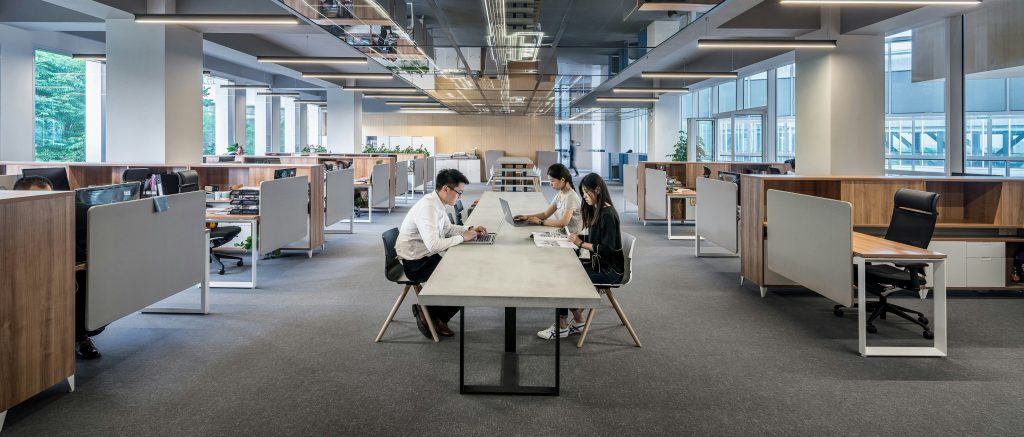The design of an office can significantly influence employee productivity and wellbeing. A well-thought-out office layout not only enhances efficiency but also boosts the overall health and satisfaction of the workforce. By understanding the effects of the environment on daily operations, businesses can create spaces that encourage both professional success and personal wellness.
This article will explore the key factors in office design, provide practical steps to create a positive workplace, and answer frequently asked questions to help you optimise your office for maximum impact.
The Psychological Impact of Office Design
Office design isn’t referring to just the aesthetics, it can have a psychological impact on employees. Colours, natural lighting, and spatial arrangement can significantly affect mood and mental health. For example, the colour blue is known to induce calmness and increase focus, while ample natural light can improve mood and energy levels. Creating a balanced environment can reduce stress and promote mental wellbeing, which is directly linked with productivity.
How Office Layout Affects Workflow and Communication
The layout of an office can streamline or hinder the workflow. Open floor plans are popular for encouraging collaboration and communication but can be distracting. On the other hand, divided spaces can boost concentration for tasks requiring focus. The key is to find a balance that supports different work styles and tasks, which will then optimise the overall efficiency of the team.
Ergonomics and Employee Health
Ergonomics is crucial in office design, aiming to minimise physical strain through proper furniture and equipment setup. Ergonomic chairs and adjustable desks help prevent chronic issues such as back pain and carpal tunnel syndrome, which are common in office settings.
Also, ergonomic practices aren’t just for health! They help to create a workspace where employees can work more efficiently without physical discomfort.
Office Aesthetics on Employee Morale
Aesthetically pleasing environments can significantly boost morale and job satisfaction. Items such as art, indoor plants, and modern furniture can make the workspace more inviting. A well-designed office can make employees feel valued and proud of their workplace, which in turn can increase loyalty and reduce turnover.
Technology in Modern Office Designs
Technology integration is essential in modern office designs for enhancing productivity. Smart office solutions like automated climate control, advanced lighting systems, and interactive displays can create a more comfortable and efficient workspace. Additionally, technology that supports remote collaboration tools is really important for today’s hybrid work models, ensuring that all team members, whether in the office or remote, are well-connected and engaged.
Simple Steps for Office Design That Boosts Employee Performance
1. Assess Your Space:
Begin by taking a look at the existing office layout. Identify areas that can be reorganised to better suit your team’s workflow and communication needs.
2. Incorporate Natural Elements:
Utilise natural light as much as possible. Consider using colour schemes that are known to enhance focus and calm, such as blues and greens. Add plants to improve air quality and aesthetics.
3. Prioritise Ergonomics:
Invest in ergonomic furniture like adjustable chairs and desks to support the physical health of your employees. Ensure that every workstation is set up to minimise strain.
4. Optimise Aesthetics:
Create an inviting atmosphere with visually appealing elements. Artwork, stylish yet functional furniture, and a cohesive colour palette can enhance morale and make the office a place employees are proud to work in.
5. Embrace Technology:
Integrate smart technology solutions that facilitate ease of use and connectivity. Consider tools that aid in climate control, efficient lighting, and remote collaboration to support a hybrid workforce.
6. Feedback:
Once changes are implemented, gather feedback from your team to see what works and what could be improved. This will help you refine the office design continuously.
FAQs
What are the key elements of productive office design?
Productive office design should include ergonomic furniture, adequate lighting, sound management, and personalised space. Balancing open areas for collaboration with private spaces for focused work is also important.
How does office design affect employee wellbeing?
Good office design promotes wellbeing by reducing physical strain through ergonomic setups and minimising stress with aesthetic and functional spaces. It also includes creating a safe and healthy environment with good air quality and temperature control.
Can office design influence company culture?
Yes, the design of an office can represent and enhance a company’s culture. It can encourage transparency, collaboration, or innovation depending on how the space is organised and decorated, reflecting the company’s values and encouraging behaviours aligned with those principles.
How to redesign an office on a budget?
Redesigning an office on a budget can involve repurposing existing furniture, opting for cost-effective yet durable materials, and implementing changes in phases. Focusing on key areas that impact productivity and employee satisfaction can also be cost-effective.
Wessex Interiors
Wessex Interiors has the expertise to transform your office into a space that enhances productivity and wellbeing. With tailored office fit-out solutions, we ensure that every aspect of your office design is optimised for performance and employee satisfaction. From ergonomic setups to advanced technological integrations, Wessex Interiors can help you create the ideal environment to support your team’s success.
Connect with the team here at Wessex Interiors today to discuss how our expert services can enhance your office environment. Visit our contact us page to fill out an online form or give us a call on 02380 663 100. We look forward to hearing from you!
